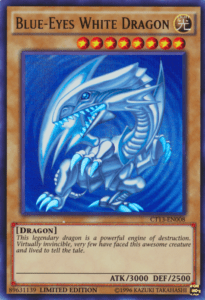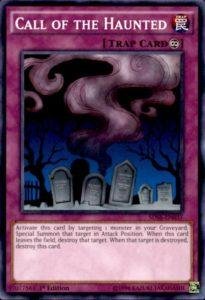This article was contributed by Team Silver Sea
“Monster Summon! Blue-Eyes White Dragon! Attack!”
I’m sure some of our readers are familiar with the above, and have shouted it at our friends and family more than once during our childhood. Indeed, Yu-Gi-Oh! (King of Games) by Konami has been a part of the childhood of many Malaysians, thanks to both a famous anime and the actual release of the cards.
For those curious about YuGiOh!, the basic idea behind it is simple. Two players use Monster Cards, Spell Cards and Trap Cards, attempting to reduce their opponent’s Life Points to Zero. Behind this simple idea, however, is a challenging and complex card game, thanks to an ever-evolving system of mechanics and rulings. As stated earlier, cards in YuGiOh can be generalized into three types. They are explained further below:
Monster Cards

Name: Blue-Eyes White Dragon (written on the top of the card)
Attribute: LIGHT (Orb to the right of the name)
Level: 8 (The amount of stars beneath the name)
Card Image: (Certain cards have different images)
Type: Dragon (Upper left of the box beneath the monster picture)
Category: Normal Monster (Background color)
Effect: None (Some monsters have effects)
Attack: 3000 (ATK value)
Defense: 2500 (DEF value)
Monster cards comprise of the bulk of an ordinary deck, and are the most recognizable part of the entire card game as a whole. A basic monster card has several characteristics that are important to the game. It has a [Name], [Attribute], [Level (Or equivalent)], [Type], [Category], [Effect], [Attack] and [Defense]. We can see the listed characteristics in the example above.
Over the years monster cards have evolved into several different categories of cards with different colored backgrounds briefly introduced below:

Normal Monster
Cards that have no effects or special conditions to summon

Effect Monster
Cards that either have a requirement or have an effect once summoned

Ritual Monster
Cards that require a Ritual Spell to summon

Fusion Monster
Cards that require two or more monsters fusing into it

Synchro Monster
Cards that require a tuner monster and one or more monsters

XYZ Monster
Cards that require two or more monsters of the same level

Pendulum Monster
Monster Cards that act like Spell Cards

Link Monster
Monster Cards that have Link Markers
Monsters can vary in terms of strength, type and effects. There are dragons, angels, demons, magicians and even outlandish creatures such as Jack O’ Lanterns. As this article is only intended to introduce the basics of YuGiOh, readers only need to understand that all these different categories belong under the greater umbrella of Monster Cards. We will delve into more details next time.
Spell Cards

Name: Monster Reborn
Type: Spell Card (Generally considered a Normal Spell Card)
Effect: Target 1 monster in either player’s Graveyard, Special Summon it
Spell cards make up the second type of YuGiOh cards. These are cards with a green background and an effect stated on the card. Unlike Monster Cards, Spell Cards are used as support, in that they have various effects ranging from searching cards in your deck to summoning monsters. Spell Cards can be activated directly from your hand by declaring the card name.
Like Monster Cards, the layout of a Spell Card has various characteristics, including [Name], [Type], [Effect]. Unlike Monster Cards, Spell Cards do not have [Attribute], [Levels], [Attack] or [Defense]. Again, the characteristics are listed using the above example.
Of course, as [Type] is an option for Spell Cards, there are various sub-types of Spell Cards that will be discussed further in another article.
Trap Card

Name: Call of the Haunted
Type: Continuous Trap
Effect: Activate this card by targeting 1 monster in your GY; Special Summon that target in Attack Position. When this card leaves the field, destroy that target. When that target is destroyed, destroy this card.
The third type of card in YuGiOh, perhaps famous due to Internet Memes are the Trap Cards. Similar to Spell Cards, these are used as support cards, but there are several key differences. Firstly, Trap Cards have a purple background. Secondly and perhaps the most important difference is that Trap Cards have to be Set on your field before they can be used, meaning they cannot be used on your turn. The layout of a Trap Card is basically the same as a Spell Card as shown above.
There are various instances in the game when a trap card has been activated. Like the oft repeated meme, players usually go “You have activated my Trap Card!” which makes for an interesting game. Like Spell Cards, there are various types of Trap Cards that will be discussed in another article.
There you have it, a basic idea behind Yu-Gi-Oh. Using nothing but Monsters, Spells and Traps, Konami has crafted a legacy that has withstood the test of time through constant evolution. This game is not only rich in flavor due to the cards, but also because of a historic anime and manga series that has accompanied the card game itself. I’m sure readers, after this brief introduction are eager to find out more and learn how to play your first Yu-Gi-Oh game. Stay tuned and we’ll introduce the basic rules of YuGiOh in our article next week!













Comments 1